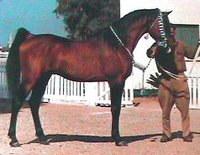There were two interesting things about *Tuhotmos and the first, was his size. At a distance, you realized that he was not tall in height. However, standing next to him, you felt that there was a lot of horse standing next to you. *Tuhotmos possessed an energy or an unamed quality of spirit that made him not only "feel" larger than he really was but also, it conveyed an emotional intelligence that was far greater than any horse and even, some humans possessed. He focused on voice, mannerisms and personal expression, to "read" people. He didn't have a lot of patience for people who would "baby-talk" to him and force their humanity upon him. He would be more responsive, if you stayed back and admired him, waiting for him to then, engage with you. It was as if he was able to read your thoughts. I know that sounds weird and I apologize for the new-agey, anthropomorphic descriptions. However, there were other people who were also affected by their personal encounter of *Tuhotmos. Two of those people made him into artwork forever: Robert Vavra and Karen Kasper.
*Tuhotmos was a critically important sire at the EAO, actually, the number one stallion in the program, before his exportation in 1973 (January 31) to America, by Rick Heber of Ranchara Arabians. As a matter of fact, *Tuhotmos was so appreciated as a sire by American Egyptian breeders, that 5 of his sons and daughters were imported to America, before it was believed that the EAO would even sell the horse:
- 1) The 1968 bay mare, *Subhaya, imported by Tom McNair
- 2) The 1970 bay stallion, *Ramses El Dar, imported by Martin Loeber
- 3) The 1971 grey stalllion, *Ansata El Wazir, imported by Don & Judi Forbis
- 4) The 1970 grey stallion, *Darrag, imported by Rick Heber
- 5) The 1971 chestnut mare, *Nazzli, imported by Gleannloch Farm
 |
| El Sareei (Shahloul x Zareefa) |
*Tuhotmos had no Nazeer blood. He was a son of El Sareei and Moniet El Nefous. *Tuhotmos is a double Shahloul horse, maybe the only stallion in Egypt to be bred in this manner, as El Sareei is a Shahloul son and Moniet El Nefous is a Shahloul daughter. El Sareei (pictured) was a striking, metallic bay-coloured stallion. While the beauty of *Tuhotmos was very expressive through the details of breed type, he was also a muscled horse, harmoniously proportioned, with a beautiful neck. He sired National Champion horses in Dressage and Trail, as well as halter. *Tuhotmos, while definitely a blend of El Sareei's substance and Moniet El Nefous' feminine charm, favors his sire more than he does his dam. *Tuhotmos also represents another successful EAO "formula", that is, blending Shaloul with Sheikh El Arab (through Wanisa, Moniet's dam). With the heavy Nazeer lines in the present day, blending *Tuhotmos with Nazeer, replicates the Mansour/Ibn Rabdan cross somewhat, which was the combination of bloodlines favored by General Pettko Von Szandtner. Almost 40% Saqlawi by strain (including his tail female line), *Tuhotmos was also 25% Hadban and Dahman, when one studies the strains of influence in the generation of his great grandparents. His sire, El Sareei, while we consider him Dahman, by virtue of his tail female line (Zareefa to Bint el Bahreyn), was actually influenced more by the Kuhaylan strain, almost 40% of his pedigree is of this strain (12.5% each of Kuhaylan Ajuz, Kuhaylan Jellabi and Kuhaylan Mimrah)! *Tuhotmos' dam, Moniet el Nefous, while sired by a Saqlawi stallion (Shaloul) and out of a Saqlawi mare (Wanisa), carries a higher percentage of the Kuhaylan strain (Kuhaylan Ajuz + Kuhaylan Mimrah), almost 40%, as compared to the Saqlawi strain, which is a smaller percentage of 25%, a percentage equivalent to the influence exerted on her pedigree from the Dahman strain.
 |
| *Tuhotmos, age 26, upon arrival at Rancho Bulakenyo |
*Tuhotmos was purchased by the Cruz family, after the death of Rick Heber and traveled from Wisconsin to his final home, Rancho Bulakenyo, in California. *Tuhotmos was 26 years old at the time. Jody Cruz said, "it was just an honor to have owned him." He lived comfortably, in the warm California sunshine, appreciated for the individual he was and the significance he had exerted in straight Egyptian breeding. *Tuhotmos lived a longer life, benefiting from the love and excellent care showered upon him by the Cruz family. *Tuhotmos was 29 years & 3 months old at the time of his death.
*Tuhotmos is one of those horses who shows us that while the recording of strain is a tradition within our breed, the modern DNA science is expanding our understanding of strain and of the characteristics which may or may not pass through the matriline, from one generation to the next.
***Portrait of a King was originally published in July of 2006 . I have updated his story a little bit, thanks to Dr. Jody Cruz for his memories of *Tuhotmos, as well as the photo. Also many thanks to Dr. William Hudson and his very significant 2 volume publication, The Matrilines of the Egyptian Arabian Horse. This blog is lovingly dedicated to both Dr. Jody Cruz and Dr. Hudson, in gratitude for their most awesome contributions to the breed.***


I had the pleasure of knowing and riding Tuhotmos' son, Masada El Rabdan. You can't imagine a sweeter or more loving stallion. He is a spectacular mover as well, with a trot that just amazes. Masada El Rabdan's son, Susar El Khamor is incredibly athletic. I once saw him perform a capriole while loose in his pen. Tuhotmos' offspring are amazing horses!
ReplyDeleteSarah Willis
Ihave a grand daughter the first time i seen her move i bought she just floats
ReplyDeleteI have a Masada El Rabdan son. He looks just like Tucky. He's coming up on 28 yrs old and my 8 yr old daughter still rides him. He's the sweetest thing.
ReplyDelete